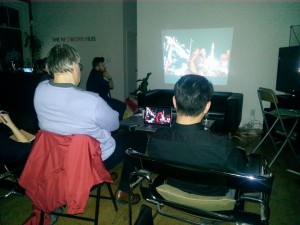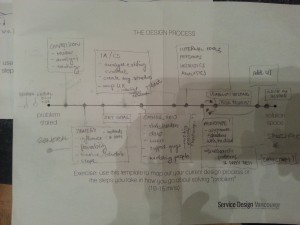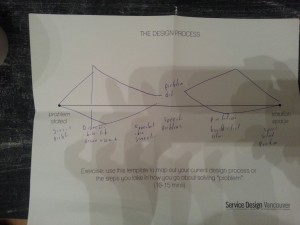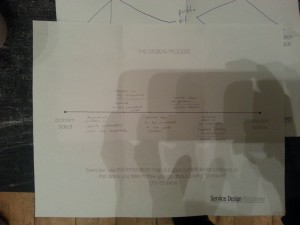Many of us designers work with briefs, sometimes detailed, sometimes lacking. In our most recent Meetup session, from Wednesday Nov 12th, we took a look at design briefs, the problem statement, and how best to go about using a design process using service design methodologies or design thinking to work towards solutions. Using service design thinking can help us to avoid pitfalls by looking at designing holistic solutions that will have better longevity.
We had our participants do a little prep homework, asking them to map out their current design processes or if they don’t work in design currently, how they would approach problem solving.
If you’d like to do the exercise yourself, download the exercise template here: DesignProcessExercise.pdf
In the first half of the meet up, Stu guided us in taking a look at a video called Briefly, where different well known designers talk about the importance of execution, human centred design thinking, and how the creative brief is iterative, ever dynamic. After viewing the video, a discussion was facilitated in how our understanding may have shifted, what we got out of it, and how it may be applied in our future works. Then we proceeded to review those who had a chance to do their homework, and let each briefly describe their process mapping.
In the second half of our meet up, we proceeded to the hands-on workshop, where we gave a real example of an anonymous brief, and asked the participants to form teams and had 10 mins to quickly do a rough draft of how they would go about ‘designing’ or create an outline of how they would proceed to design the solution. The basic premise was that they have been given a general problem statement by a potential client, and now as an agency or team of service designers, what would be their next steps and recommendations on how to proceed forward. Even though the client asked for a tool to be designed, the information provided by the client showed that there were underlying issues beyond their specific problem statement.
Post exercise, we asked the teams to quickly present their work, where it was great to see how much their design process had already changed since seeing the video and having had a discussion on the merits of following a human centred design process, and already started to resemble our Double Design Process in the mapping out of their strategies. Teams picked up on how research was needed not only to find out context for the tool requested, but also needed to find out the Why’s, getting deeper context.
We then formally introduced the Double Diamond Design Process in order for them to gain the deeper understanding of methodology used within Service Design. We wanted to drive home in how the design process needs to be iterative and human centred, thus and had one of the facilitators, myself in this case, present a case study from one of my projects worked on, to give real world references. It was a rewarding session, as everyone with different levels of experience and knowledge came to similar understand and were able to engage with one another on just how complex some design challenges can be and how to make use of the Double Diamond Design Process, as well as briefly touching upon a few research methods used in iterations can help to design at a deeper and more holistic level. We felt the high engagement level, now sensing that everyone felt more empowered being armed with a design process that they better understood and saw the benefits with practicing it.




